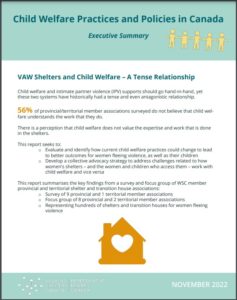 Child welfare and intimate partner violence (IPV) supports should go hand-in-hand, yet these two systems and sets of services have historically had a tense and even antagonistic relationship. This environmental scan looks at how VAW shelters/transition houses (THs) have engaged with child welfare services across Canada, the barriers and challenges they have experienced, as well as best practices emerging.
Child welfare and intimate partner violence (IPV) supports should go hand-in-hand, yet these two systems and sets of services have historically had a tense and even antagonistic relationship. This environmental scan looks at how VAW shelters/transition houses (THs) have engaged with child welfare services across Canada, the barriers and challenges they have experienced, as well as best practices emerging.
The Advisory Council members identified in 2021 that there was a need to look at the ways child welfare agencies and VAW shelters/THs interact and collaborate to support women and children experiencing family violence, and develop a plan of action for addressing challenges. The objective of this study was to strategically evaluate and identify where there is potential for change to child welfare current practices that will lead to better outcomes for women and their children. The goal of this scan was to develop a collective advocacy strategy to address challenges related to how VAW shelters/THs work with child welfare and how child welfare engages with women and their children experiencing IPV.
This report summarizes the key findings from a survey of our members, which identified challenges arising for VAW shelters/THs in their interactions with child welfare systems and caseworkers. In addition to the survey data, provincial/territorial legislation was examined, as was a small body of supporting literature. To conclude the study, a focus group was hosted with members to fill in gaps in the research and add to the list of resources and best practices. The report concludes with a set of promising practices and aligned policies that support improvements to child welfare as they pertain to IPV.
This study was supported by a small, but dedicated Advisory Committee including the BC Society of Transition Houses (BCSTH) and the Transition House Association of Nova Scotia (THANS).
